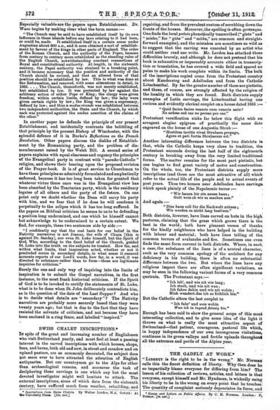SWISS CHALET INSCRIPTIONS.*
IN spite of the great and increasing number of Englishmen Who visit Switzerland yearly, and must feel at least a passing interest in the carved inscriptions with which houses, shops, inns, and barns, both old and new, in street and meadow and on upland pasture, are so commonly decorated, the subject does not seem ever to have attracted the attention of English antiquaries. But our countrymen go to the Alps for other than archaeological reasons, and moreover the task of deciphering these carvings is one Which any but the most devoted investigator might well hesitate to attack. The external inscriptions, some of which date from the sixteenth Century, have suffered much from weather, rebuilding, and • Inscriptions from Siriss Chairts. By Walter "Arden, M.A.; Oxford : At the University Press. [I5s. net.]
repairing, and from the prevalent custom of scrubbing down the fronts of the houses. Moreover, the spelling is often grotesque.
One finds the local patois phonetically transcribed (" giete " and "miehe," for " gate" and " miihe," are common and straight.. forward examples), and the mistakes are sometimes so wild as to suggest that the carving was executed by an artist who
could neither read nor write. Mr. Larden has attacked these difficulties bravely, and although he does not pretend that his book is exhaustive or impeccably accurate either in transcrip- tion or translation, he has covered a wide field and spared no Pains to make his work complete within its limits. The bulk of the inscriptions copied come from the Protestant country about Kandersteg and Adelboden and from the Catholic
Lotschenthal. By far the greater number of them are pietistic,
and these, of course, are strongly affected by the religion of the locality in which they are found. Both districts supply examples of Latin carvings, the Lotschenthal having one curious and evidently clerical couplet on a house dated 1665 :—
" Quid facies facies veneris cum veneris ante? Ne sedeas sed eas ne pereas per eas."
Protestant versification sinks far below this flight with an arrogant elegiac epigram of practically the same date
engraved on the house of one Augustin Strub "Hostibus invitis vivat Strubaea propago, Agere et pati fortia Strubaeum est."
Another interesting difference between the two districts is that, while the Catholic keeps very close to tradition, the Protestant succeeds during the last half of the eighteenth century in breaking away from the very limited traditional forms. The matter remains for the most part pietistic, but one begins to find great variety of metre and construction. On the whole, too, the Protestant districts supply more inscriptions (and these are the most attractive of all) which refer to the actual life of the people and to actual events of past years. Thus two houses near Adelboden have carvings which speak plainly of the Napoleonic terror :- " Wir bauen hir ein neues haus ; Gott weis ob wir es machen aus."
And again :— "Dies haus sell fur die Nachwelt niitzen ; Wir werden es nicht lang besitzen."
Both districts, however, have lines carved on huts in the high. pastures, claiming that the grass which grows there is the best in the world; both have pleasant verses of thanks for the kindly neighbours who have helped in the building with labour and material; both have lines telling of the. common terrors of avalanche and fire. Sometimes one even finds the same form current in both districts. Where, in such a case, the substance of the lines is of a neutral character,
such as the very common apology of the architect for any deficiency in his building, there is often no substantial difference between the two. But where the lines have any religious import there are often significant variations, as may be seen in the following variant forms of a very common quatrain. The Protestant says :-
"Ich leb', und wis nit wie Lang; Ich sterb, und wis nit wan ;
Ich fahre dahin und wis nit wohin ; Mich wundert.das ich so frohlich bin," But the Catholic alters the last couplet to
"Ieh fabr' und weis wohin Wan ich in tugend fleissig bin."
Enough has been said to show the general scope of this most interesting collection, and to give some idea of the light it
throws on what is really the most attractive aspect of Switzerland—that patient, courageous, pastoral life which, in happy independence of our own incongruous visitations,
continues in its green valleys and fertile uplands throughout all the extremes and perils of the Alpine year.














































 Previous page
Previous page